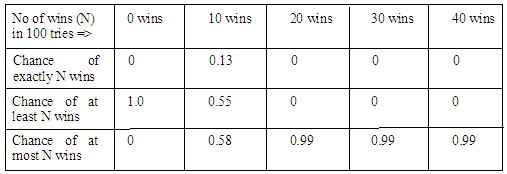Research shows that compulsive gambling arises from increased activity in a part of the brain, says S.Ananthanarayanan.
Gambling is not rational behavior. Taking a chance, when the odds are fair, is often a good thing to do, but gambling is a quest for an outcome that is better than the odds. As gambling systems are usually with the odds slightly against the player, in the ‘long run’, it is certain that the player would lose. But playing against the odds is usually the result of a delusion, and generations of gamblers have tossed fortunes away in the belief that the outcome in their own case would be different.
Luke Clark, Bettina Studer, Joel Bruss, Daniel Tranel and Antoine Bechara of the Universities of Cambridge, Iowa and California, reports in the journal, Proceedings of the National Academy of Sciences of the USA (PNAS), that it may be a part of the brain, a part that drives tendencies that make us human, that is hyperactive in the case of compulsive gamblers.
The fact of the matter is that most people are gamblers to some degree.”73% of people in the UK report some gambling involvement in the past year”, says a study conducted in 2010. There are staid household ladies who set aside a part of the family budget for the State Lotteries and moderate chance taking at the card table, or even the racecourse, is viewed as sociable and stress relieving behavior. And then, many gambling schemes are presented like ‘opportunities’ and the accounts of people who were ruined are viewed as cases where the victims made a ‘mistake’ while playing, rather than a reason to stay away from the elusive promise of windfall returns
When the New York Cotton Exchange closed down, the Mumbai underworld filled the gap for speculation with the game of ‘Matka’. The scheme was that players (read victims) placed bets on an ‘opening’ or a ‘closing’ number, which could be 0 to 9, for the chance to win 9 times the money staked. It is obvious that the Matka operator would win, in the ‘long run’, because he would receive ten units for every nine units he paid out.
Yet, generations in Mumbai, and even from elsewhere by ‘trunk call’, played Matka with zeal and determination. How did they expect to profit? A number of ‘systems’ were developed. If a player took it that she would win once every ten time she played, and she played Re 1 each time, she had to be just a little lucky to win Rs 9 before she had invested the full Rs 10. And once she had won that Rs 9, she could take it that a new series had started. A popular system was when a punter doubled her bet every time she played. Then, no matter when she won, she would cover well over everything she had lost till then. Such high investors must have been popular with the operators.
The trouble is that it is far from certain that a punter would win once in every ten tries. This is because in 10 tries, there all kinds of possible outcomes – no wins at all, exactly one win, exactly 2 wins, 3 wins and so on. To have no wins means to lose every time. Losing any one time has a 9 in 10 chance, or 0.9. For this to happen 10 times in a row, the chance works out to 0.35. But the chance of winning at least once, which is nothing but the chance of avoiding losing every time, comes to 0.65, which is nothing but 1.00 minus 0.35. But 0.65 is a lot less than the expectation of being sure to win once in every ten tries!
The probability of 0, 1, 2, 3,4 wins out of ten tries has been displayed in Table 1. We can see that the chance of greater numbers of wins rapidly falls, and the chance of at least 1 win is the sum of the chances of exactly 1win and of at least 2 wins, and so on
Table I – chances of wins in 10 ties

The chances of winning at least once out of ten tries gets even lower as the total number of tries is increased. In the second table, for instance, the chance of at least 10 wins in 100 tries is 0.55. In 100 tries, in fact, it is almost certain that one would win at least 5 times, but the chance of winning at least even 11 times drops to 0.42.
Table II – chances of wins in 100 ties

The ordinary visitor to the casino does not need to know all this mathematics – a few rounds of playing and losing a few thousands at the table should convince the visitor the she would be better off doing other things. But because some wins keep happening, she thinks a ‘bad patch’ is against the law of probability, which is going to be set right in the next throw, and she places another bet.
Research findings
The researchers featured in PNAS take note that persistent gamblers often treat ‘near misses’ as different from any other outcome or that they act out the gambler’s fallacy, of viewing a series of losses as a reason for the next play to fall outside the series, in the form of success. Gamblers “display an array of cognitive biases that create a distorted expectancy of winning,” the researchers say in the paper. The group then conducted trials to see if it were a feature of the brain that was behind this error of judgment in habitual gamblers.
To see if it were a feature of the brain that was responsible for this delusion that they would win, in compulsive gamblers, the group tested a number of persons with injuries in specific parts of the brain, and also persons with no injury, with typical gambling situations. ”While neuroimaging studies can tell us a great deal about the brain’s response to complex events, it’s only by studying patients with brain injury that we can see if a brain region is actually needed to perform a given task,” Dr Clark, the leader of the research team says.

The experimental subjects were presented with two gambling situations, one a slot machine where there were ‘near misses’ and another, a roulette table where the players faced a series of losses, to suggest that the next play would be different. The disability of the players with brain injury was in the frontal part, which in the insula, a part in the centre of the brain, which is now thought of as the seat of social emotions, like lust and disgust, pride and humiliation, guilt and atonement.
The result of the trials was that except for one category, all subjects, including the ones with no injury, were motivated to keep playing when they got ‘near misses’ at the slot machine or ‘continuous losses’ at roulette. But the category which stayed rational and quit, was the one with injury to the insula. The insula, it seems was the one that pushed people to be fanciful and take chances. The inusla surely serves a purpose, in endowing humans with emotions, imagination and wishful thinking, which have their value, but switching of the insula seems to protect people against irrational gambling. “Based on these results, we believe that the insula could be hyperactive in problem gamblers, making them more susceptible to these errors of thinking. Future treatments for gambling addiction could seek to reduce this hyperactivity, either by drugs or by psychological techniques like mindfulness therapies”, says Dr Clark.
------------------------------------------------------------------------------------------